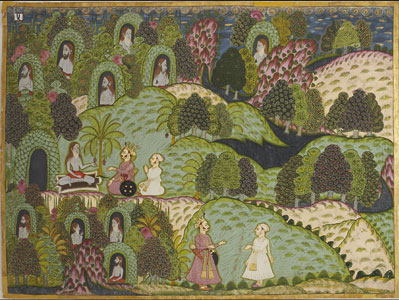
Garden and Cosmos: The Royal Paintings of Jodhpur
Issue 58 July 2009
Dating from the 18th and early 19th centuries, these paintings on view at the British Museum have never left India before. The terms ‘Garden’ and ‘Cosmos’ are metaphors for two different trends in the paintings from this region; pleasure and metaphysics. ‘Garden’ includes the paintings that depict life in the royal palaces, extravagant parties in lush flowering gardens on the edge of the desert and pavilions, or scenes from the epic Indian poems such as the Ramayana. In ‘Cosmos’ the paintings depict philosophical speculation on matters such as the creation of the universe.
Court painting in India is famous; its precise portraiture was first made for the Mughal emperors, who imported a Muslim aesthetic that flourished to become one of the world’s most delicate schools of art. Hindu courts fused this fine style with traditions thousands of years old. To judge from these Rajasthani portraits of the royal family of Jodhpur-Marwar, the results are unexpected and strange.
The Maharajah Bakhat Singh picnics by moonlight in pictures of palace life, and in other eye-popping visions of his decadent kingdom, elephants race and courtesans convene in exquisitely dreamlike settings. Hedonistic scenes take place in a rich landscape that seems only partially tamed. The paintings are colourful, and though I personally have never liked the style, the detailing has to be applauded. A celebration of the festival of Holi depicts a court spraying each other with red and yellow dye, in imitation of Krishna and Radha. The artist has splattered pink and saffron colour over the image – as if the painting was done amid the joyful mood of the festival. It’s easy to sense the boisterous, self-indulgent fun of it all, jostling frivolity threatening to leap from the canvas.
The first part of the exhibition could have been called The Three Kings, as the painting show the progression from pleasure to a higher plane. Images of Bakhat’s successor, Vijai Singh, are loaded with creation myths and epics in swirls of colour. The Maharajas all had particular, different obsessions; and the exhibition moves from the constrained garden within the fortress to the more open landscape of the forest. And then came Man Singh, the ruler from 1803 – 1843, whose was deeply influenced by the Naths, yogis invariably positioned in leg-bending squats atop jutting fields of colour.
From a courtly world, the exhibition leads into abstract realms of the spectacular where Brahma, god of creation, emerges from a golden lotus flower that sprouts from the navel of Narayana in a shimmering grey abstract ocean. The increasingly surreal quality continues in the images of the grey-blue ashen body of an ascetic named Jallandharnath, seated among blooming jungle flowers and trees. He had a huge following of people who passionately believed in his immortality, and the Nath gurus who followed his teachings were given huge powers. The paintings done during this reign of Man Singh suggest a court rapt in introspection while the British took over India. Interestingly, with time the entwined motifs of the cranes are replaced by guns.

The dependence on formula and pattern-making could be intriguing, but the overall effect scaled disproportionately according to caste becomes tedious. The British colonisation of India meant that court painting was inevitably discontinued, but by token of these paintings, I am inclined to think that this small cultural phenomenon may have already been hindered in aesthetic decline. The artists’ incomprehension of perspective flattens space and architecture. Profiles seem clumsy and crudely drawn. Some portraits show figures in full frontal and three-quarter view but these are comparatively few, most show a side profile (as rulers are on coins).
The silk-embroidered tent at the start of the exhibition was interesting, but seemed less than ordinary suspended above a series of paintings depicting garden scenes. The treatment of the cosmos at the end of the exhibition seems vacuous, and not so different from the garden court scenes. These gardens are not places of contemplation for the solitary philosopher, but thickly peopled scenes. Paintings from the reign of Man Singh turned away from the glowing world of court life, instead making philosophical speculations about the origin of the universe. The large fields of distinctive, brilliantly coloured wave patterns reminds the viewer that surrender to blocks of pulsating colour are not unique to 20th century European aesthetic.
Six panoramas come in mono-colour: yellow, deep pink, grey, orange, and two whites. These wide voids each has a group of three figures floating halfway across. The coloured backgrounds are painted with spiral whorls that overlap like fish-scales, which seem to be the schematic way water is often done in all these Jodhpur pictures – hence the title Cosmic Oceans. The figures’ identities can only be guessed at and the precise meaning of these paintings is unclear. I am left with the feeling of a fluid idea meeting something staccato, and don’t particularly want to make the rounds again.
To complement their Indian Summer theme, the British Museum has collaborated with Kew Gardens to create an Indian-themed landscape. This plant exhibition takes visitors on a journey from the mountainous environment of the Himalayas, through a temperate region and ending in a sub-tropical zone centred on a pool filled with lotus flowers, and was a pleasant way to end my museum visit. It highlights the significance of plant use in Indian culture – as food, medicine and in trade and the way plants such as chilli (native to South America) have travelled and become completely indigenised. Finally, the dramatic consequences of habitat destruction in the subcontinent will also be addressed. This exhibition is free and can be found on the Museum’s west lawn.
‘Garden & Cosmos: the Royal Paintings of Jodhpur’, showing at the British Museum, London WC1, until 23 August, £8.
The British Museum - Garden and Cosmos
Bookmark this |
|
Add to DIGG |
|
Add to del.icio.us |
|
Stumble this |
|
Share on Facebook |
|
Share this |
|
Send to a Friend |
|
Link to this |
|
Printer Friendly |
|
Print in plain text |
|


Comments
0 Comments